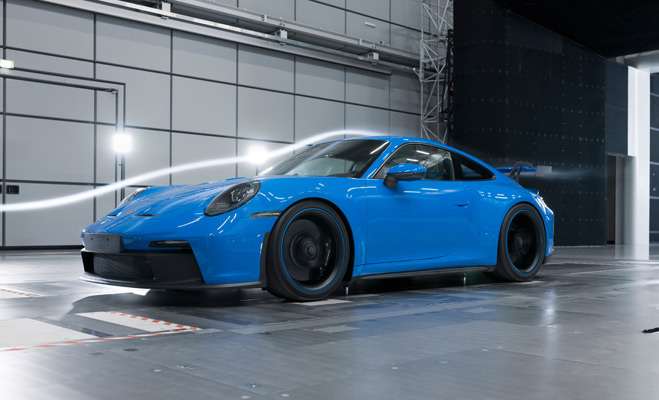
The new Porsche 911 GT3 is filled with technical innovation.
During development, the engineers had one goal in particular: to further enhance the performance of this sports car without sacrificing everyday usability. The cooperation between the technical specialists of the production car development department and the specialists of the Motorsport section played an extremely important role here.
Porsche 911 GT3
“When the same engineers who build our racing cars are designing a new GT road car, there is the most direct technology transfer I can imagine,” said Andreas Preuninger, GT Lineup Director.
Over 160 hours of wind tunnel fixes
The technical progress of the new 911 GT3 is particularly noticeable in the field of aerodynamics. For the first time in a Porsche production car, a suspended rear wing with a swan neck attachment, similar to the GT 911 RSR and 911 GT3 Cup racing car, is installed. Because two aluminum supports hold the wing element on top, airflow can flow smoothly from below, which improves aerodynamic responsiveness. The new design allowed to reduce flow losses and increase the clamping force. What's more, when combined with many other treatments, it resulted in a well-balanced adverse lifting condition.
“About 700 simulations were required to develop the aerodynamics of the new 911 GT3. We spent over 160 hours fine-tuning the car in the wind tunnel,” said Matthias Roll, Aerodynamics Engineer.
The angle of the new rear wing is adjustable in four different positions to choose from. The front diffuser is also adjustable in four positions.
“At 200 km/h and factory-spec, the new 911 GT3 produces more downforce on the 50% than its predecessor. In maximum downforce mode, the increase is more than 150%,” Roll added.
As in racing, the aerodynamic balance of the new 911 GT3 can be individually adapted to track conditions and individual driving style.
“Both the components and the way they are developed are similar to those used in our racing cars,” the engineer explained. “In our state-of-the-art wind tunnel in Weissach, we don't just drive straight, we simulate all possible driving situations. We force the car to lean sideways and longitudinally, as well as deviate from the track, to reproduce the physical impacts on the track.”
High-revving engine with racing DNA
Even more laborious was the bench testing of a 4-liter high-speed naturally aspirated engine.
“In total, the engine of the new GT3 has spent more than 22,000 hours on the test bench. During testing, we repeatedly simulated typical track profiles, and the unit ran at full throttle for a very long time,” said Thomas Mader, GT Road Engine Project Manager.
The engine spontaneously responds to pressing the accelerator pedal and is based on the racing unit of the GT3 racing car - 911 GT3 R. and goes to the 911 GT3 Cup almost unchanged. Its power is 375 kW (510 hp) at 8400 rpm - 10 hp. more than the previous GT3. The electronic limiter works only at 9000 rpm. The maximum torque has been increased from 460 to 470 Nm.
As in motorsport, rigid valve lifters ensure precise valve operation at high RPMs. Proven VarioCam technology provides camshaft control based on engine speed and load conditions. Crankshaft with large diameter bearings, wide liners and plasma coated cylinder liners provide lower friction losses and at the same time reduce wear.
“Customized throttle positioning is taken from the world of motorsport and greatly improves response,” said Mader, Engine Specialist.
Due to the significant longitudinal and lateral accelerations that the new 911 GT3 creates on the track, it is especially important to supply the high-revving engine with oil. As in motorsport, the lubrication system uses a dry sump with a separate oil reservoir. Seven stages of oil suction ensure fast and efficient oil return to the external reservoir. Lubrication of heavily loaded connecting rod bearings occurs directly from the pump through the crankshaft.
“The engine of our racing 911 GT3 Cup is fundamentally different (from the 911 GT3) in only two components: the exhaust system and the control unit. Everything else is identical,” Mader explained.
Engineers and development drivers also tested the engine of the new 911 GT3 outside of the test rigs. “In order to meet the stringent standards, we performed 600 emissions tests during the design phase,” said Thomas Mader.
There were also very strict requirements for the durability of the power unit: it had to work flawlessly, without interruption, over a distance of more than 5000 km while overcoming the oval of the Italian Nardo track at a constant speed of 300 km / h. ; stops are for refueling only.
Porsche is offering the new 911 GT3 at a price of 883,000 rubles. c.u. (4 c.u. = 1 USD). Deliveries of the first copies are scheduled for May 2021.
Photo: Porsche










